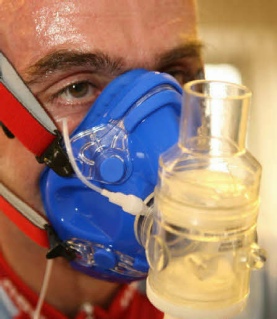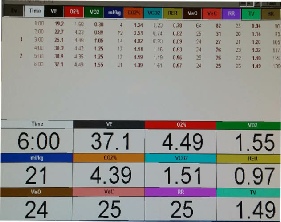

A rugged supported respiratory gas analyser, ideally suited to organisations who require accurate reliable monitoring of cardiovascular fitness, where repeatability is of prime importance.
All the usual response to exercise measurements are reported. You will want reliable measurements, so Here is a protocol that you can use to confirm that your analyser is performing correctly.


Over the years we’ve worked with many clients, each having one thing in common – the wish to provide scientifically accredited aerobic measurements – without breaking the budget.
Our emphasis on repeatability makes our analyser particularly suitable for cardiovascular fitness screening, monitoring and evaluating the effectiveness of cardiovascular programmes.
Our analyser has been ruggedised, so it’s also ideal for use in busy teaching laboratories, where students’ can get hands on experience with an on-line system, with little risk of causing expensive accidental damage.
Mixed Expired Gas Analysis
Our decision to use mixed expired gas analysis instead of Breath-by-breath analysis is based on the ever decreasing time that is available for analysing each breath directly (often less than 500ms). Timing has implications concerning repeatability, where sampling conditions should remain as constant as possible.
The COVOX Mixed Expired Gas Chamber has an internal capacity of just 500 ml, allowing much quicker sampling than standard sized chambers due to the small volume of air required to flush the chamber. The design eliminates end tidal volume bias, and being constructed of thin walled thermo-plastic, quickly assumes the temperature of exhaled air, preventing condensation within the chamber itself.
See Redbackbiotek for their Mixing Chamber Vs Breath by Breath article.


The COVOX Metabolic Cart detects instantaneous inspired respiratory air during each breath using a Fleisch pneumotachograph, the device we use, which due to its excellent linearity and turn down ratio of 20:1, allows accurate measurement of pulmonary ventilation (Ve) from rest to VO2max. The single flow head meets ISO 26782:2009 spirometry standard, ISO 23747:2007 and fulfills all the ATS/ERS:2005 guidelines.

The advantages of Fleisch diagnostic flow measuring systems include: Accurate and linear measurements throughout the flow range, robustness and no moving parts. Pneumotach moisture contamination is avoided by measuring inspired respiratory air, thereby eliminating surface condensation and contamination from moisture in the breath. An ultra low resistance filter is used to capture dust particles, further protecting the flow head.
COVOX uses the Teledyne UFO oxygen sensor, which was specifically developed as a reliable alternative to paramagnetic and optical sensors. The Teledyne UFO utilises fuel cell technology that is inherently rugged and forgiving.
Unlike many other sensors the UFO is insensitive to shock, vibration and will withstand exposure to moisture without damage. With an average response time of 100 milliseconds, the UFO is one of the fastest oxygen sensors in general use.
The sensor meets ISO 7767 (1997), ASTM F1462-93, and CE Medical Devices Directives.
Accuracy better than +/- 1.0% Reading
Resolution 0.1%

Accuracy
Typically +/- 2 %, Min Flow 0.02 l/s, Max Flow 16 l/s
Linearity +/- 1%
Preventive maintenance is not required. The gas sampling circuit is protected against the accumulation of expired gas moisture using a Perma Pure Nafion dryer. A reflux arrangement removes the need for regular dryer replacement.
Hybrid.
The COVOX Approach is to use simultaneously, breath-by-breath measurement of pulmonary ventilation (where sensors are capable of high sampling rates), and a mixed expired gas chamber for Oxygen and Carbon dioxide analysis.
Industrial. At the heart of the system is an embedded industrial PC, running under the Windows Embedded Operating system. All the components used in the construction has a history of industrial use - reliability being of prime importance.
Breathing Circuit
The exercise non re-breathing valve allows air to be inhaled through the pneumotach and then vented through a mixing chamber where the expired gas is presented for analysis.
Recurring Gas Sampling Sequence
At the start of each minute room air is purged through the gas sampling circuit and analysed for ambient (ie. inspired) oxygen and carbon dioxide concentration (FiO2) and (FiCO2). This period can be set between 10 and 25 seconds. Note that during this phase Ve continues to be measured, expired gas continues to be mixed and the chamber ‘updated’, but measurements are not reported.
After the room air purge period, expired gas is drawn from the mixing chamber for analysis. VO2 is updated and displayed after each breath.
Predictive Sampling Option
When selected this option predicts minute VO2 after each breath. The prediction improves as the minute sampling interval progresses.



























In the period of approximately two years since installation, COVOX has provided excellence in reliability in measurements and ease of operation. This gas analysis system has been used in approximately 7,000 exercise test analyses. It has successfully formed part of the integrated approach to teaching, research and consultancy. Ian Swaine, DEMontford University
I thought you would be interested in the present position with regard to the practical use of the COVOX Microlab in respect to non-research work within the Constabulary. All officers eligible for promotion are required to undergo a fitness assessment in order to achieve the desired level of cardiovascular performance before taking up a new post. May I take this opportunity, yet again to thank you for supplying such a suitable medium for such a demanding schedule of assessments.
David Clarke, Force Physical Education Officer, Devon and Cornwall Constabulary
I would like to thank you on behalf of West Mercia Constabulary and the NSPCC Marathon Team for the personable and professional way you conducted yourself, and the quality of the information you delivered to the group. We were all very impress by the technology (COVOX Analyser). It has given us food for thought for the future. I am sure it will go a long way to ensuring that we achieve the right result in the marathon. David Thursfield, Deputy Chief Constable, West Mercia Constabulary
I have found the COVOX to be robust, reliable and user-friendly and I can strongly recommend it for use in student laboratory work. Dr Neil Armstrong, Reader in Exercise Science, Director, P.E.A. Research Centre, University of Exeter
I have been using the COVOX Gas Analysis System since 1988 in Leisure Centres in Teignmouth and Torbay. It provides an accurate measurement of oxygen consumption, which is reliable and repeatable. I have been very satisfied with the apparatus and with the results that it provides.
Dr P.R. Travers, M.B.,B.S., D.Phys. Med
I am pleased to report many years of excellent performance from our COVOX System. We have only two problems at the moment : 1) Can you send us a replacement dryrite container. A student dropped the original. 2) The software occasionally crashes, usually at the point of printing out the results, I think because the datafiles are almost full. How do we fix this problem? I would be interested in your comments on the longevity of our COVOX and if you think upgrades are possible. Please send a current brochure. Dr Martin Farrally, St Andrews University.

A simple protocol that incorporates quality control
Background
Studies have shown that all of us, regardless of size, but with normal mechanical efficiency, consumes about the same amount of oxygen at each watt workload seated on a bicycle ergometer. It’s been reported that this generally holds true up to about 150 watts workload.
Cranking the pedal in each case requires about the same number of cross-bridge cycles per minute of muscle contraction (ref Huxley and Simmons et al), and therefore about the same amount of ATP.
The data shown in the following table was published by the University of Innsbruck. Similar values have been reported by Washington University.
|
Watts
|
50
|
100
|
150
|
|
Typical VO2
|
1.073
|
1.564
|
2.097
|
The cycle ergometer steady state ramp protocol below uses the data shown in the table as ‘check’ values to confirm that the analyser is functioning correctly. Note however that these are average values, so you should expect some variation. Ensure also that your cycle ergometer is able to measure watts workload accurately.
If you are testing trained athletes you might consider starting the test at a higher workload, and if necessary exceed 250 watts. Ideally the test should not last more than 15 minutes or so to avoid local muscle fatigue, where in simple terms the legs may give out before breathing ability.
|
Minute
|
Watts
|
Check VO2
|
|
0 - 3
|
50
|
1.073
|
|
3 - 5
|
100
|
1.564
|
|
5 - 7
|
125
|
|
|
7 - 9
|
150
|
2.097
|
|
9 - 11
|
175
|
|
|
11-13
|
200
|
|
13-15
|
225
|
|
15-17
|
250
|
The first 3 minutes are used as a warm up period, and allows the subject to get used to the breathing equipment. Workload is then increased every 2 minutes. Observe the check VO2’s at the end of the measuring period and before increasing the workload.










































